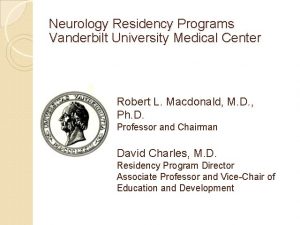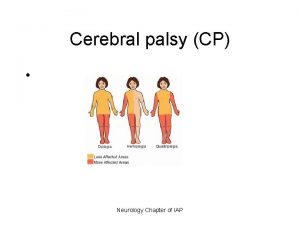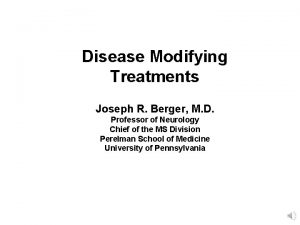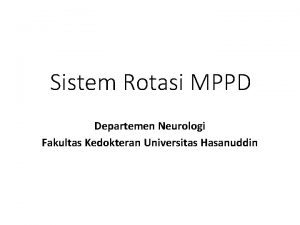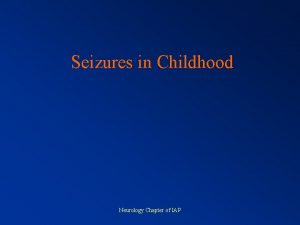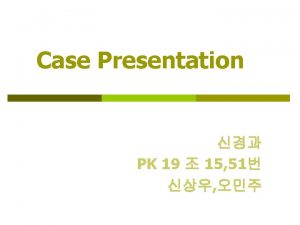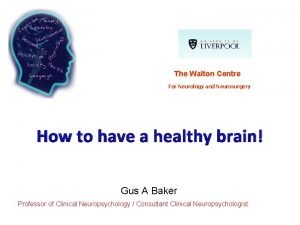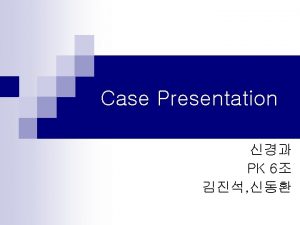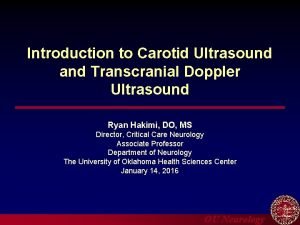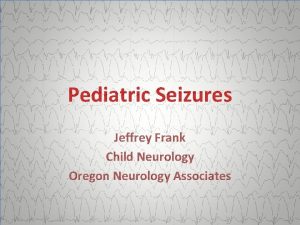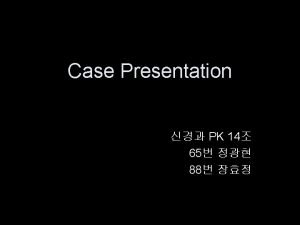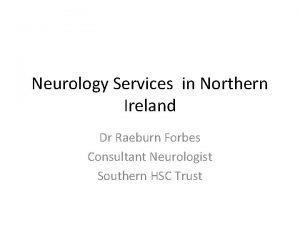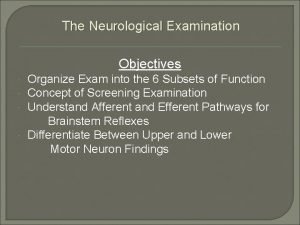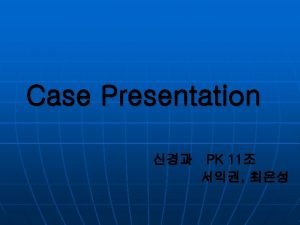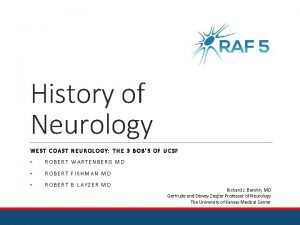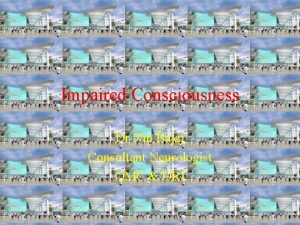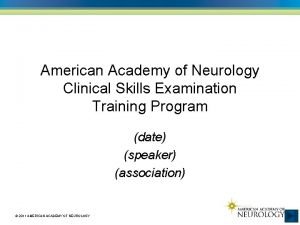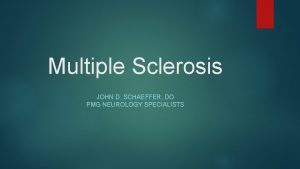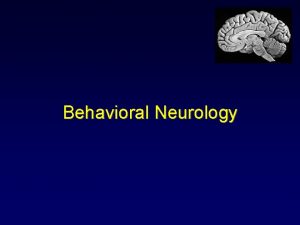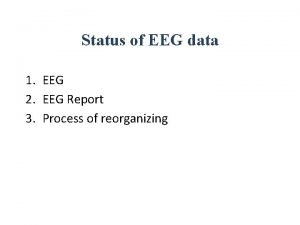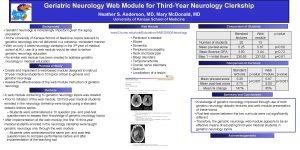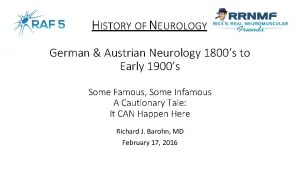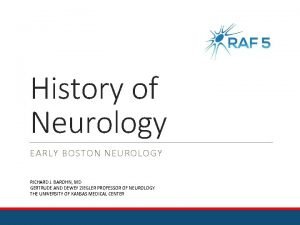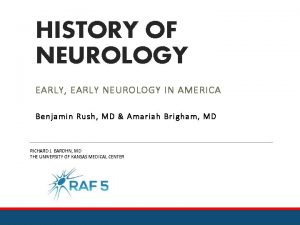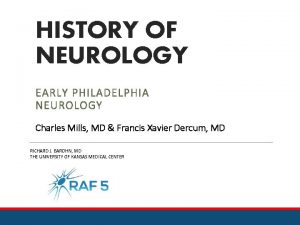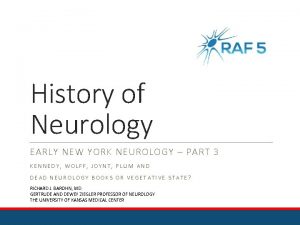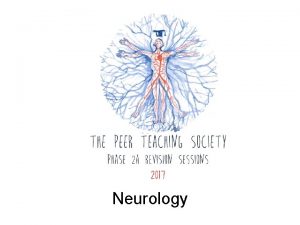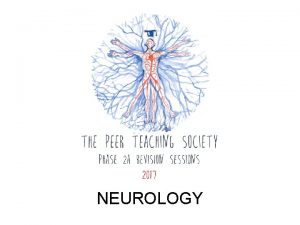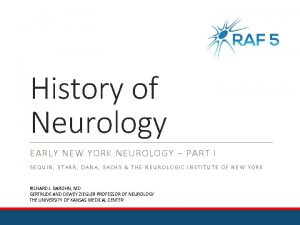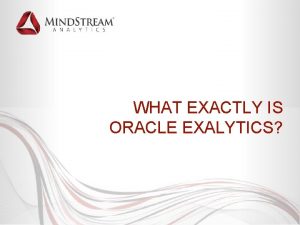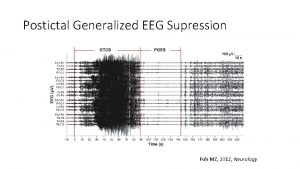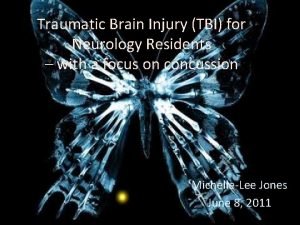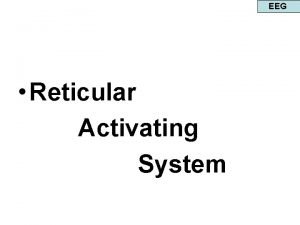EEG For Neurology Residents 2009 Not exactly EEG










































- Slides: 42

EEG For Neurology Residents 2009

Not exactly EEG, but… …things you need to know. 1. Epilepsy and driving. 2. Epilepsy and pregnancy

OUTLINE I. What is an EEG and how is it recorded ? II. How do you read an EEG ? III. The use of EEG IV. Slideshow/Quiz

PART I WHAT IS AN EEG AND HOW IS IT RECORDED?

Recording procedure 20 -30 minutes, relaxed patient Eyes opened/closed Photic stimulation, Hyperventilation +/- sleep +/- pain, noise


PART II HOW DO YOU READ AN EEG ?

Why do you need to know this? • Exams • Emergencies • To understand the reports

An organized approach 1. Orient yourself. 2. Is there normal brain activity present or is it altered ? 3. Is there abnormal activity present ? 4. What is the state ? 5. Is it age – appropriate ? 6. Are there any artifacts present ?

1. ORIENT YOURSELF Montage (bipolar or referential) Time scale Sensitivity (amplitude, positive/negative) Other channels (EKG, EOG) F 7, F 8

2. Is there normal brain activity or is it altered? • Is the stuff that is supposed to be there actually there ? • Is there evidence of a structural lesion or a toxic/metabolic process that has altered the normal EEG background activity?

Normal brain activity • Waves: Delta Theta Alpha Beta 1 -3 Hz 4 -7 Hz 8 -12 Hz > 12 Hz • Posterior dominant alpha rhythm with eye closure. • Alpha rhythm ≠ alpha frequency • Low amplitude, frontal Beta activity.

The typical EEG

Normal deviations from normal (!) 1. 2. 3. 4. Drowsiness Sleep Age (young and old!) Activation procedures (a) Hyperventilation (b) Photic stimulation

Background abnormalities • Slowing (theta or delta) • • • Focal or diffuse Bilaterally synchronous or not Rhythmic vs. irregular/polymorphic High vs. low amplitude Intermittent vs. continuous • Can be more subtle • Attenuation of amplitude • Asymmetry of alpha Etc…

Focal slowing

Generalized slowing Ebersole & Pedley

Summary • Focal slowing = rule out structural lesion • Generalized rhythmic slowing = consider deep structural lesion or destructive process • Polymorphic generalized slowing = very nonspecific “Disturbance of the background activity”

3. Abnormal activity Is there any stuff there that should not be there at all ? Not simply alteration of the background Usually, we are asking if there is epileptic activity (interictal or ictal).

Focal Inter-ictal activity • • Spikes and sharp waves ! Phase reversal Recurrent and consistent With a field Followed by slow wave Asymmetrical Not explained by artifact

Focal epileptic activity

Focal epileptic activity

Terminology “Potentially epileptic abnormality” “Epileptiform abnormality”

Phase Reversal

Non-epileptic phase reversal (normal background activity)

Generalized Inter-ictal Activity Generalized spike and wave

Ictal Activity (Seizures) • Electrographic lasts > 10 sec • Seizures not defined by single pattern; spikes, spike and wave, slowing, attenuation etc… • Rhythmic activity that changes with time

Partial complex seizure with secondary generalization

Neonatal seizure

Neonatal seizure cont…

3 Hz spike and wave (from Ebersole and Pedley)

Summary • Interictal epileptic activity = spikes and sharp waves • Ictal epileptic activity = evolving rhythmic activity

4. State • 4 Sleep stages, plus REM 1. Lose α, slow EOM, v-waves 2. Spindles, K-complex, v-waves 3. Delta < 50% 4. Delta > 50% REM: -looks normal (i. e. awake), need EOG, EMG etc… • Sleep onset • Most consider stage 1 sleep = drowsiness • But…some define sleep onset as appearance of vwaves, others as sleep spindles.

Don’t Forget… 5. Age • Prior to birth, continuous evolution of EEG • Posterior-dominant rhythm by 6 -12 months; alpha frequency by 4 -8 years 6. Artifacts • EKG or pulse • Eye movement • Electrode • Muscle/movement • Electrical • Weird and wonderful

Electrode artifact

Eye Movements

EKG Artifact

Head movement artifact during a pseudoseizure

So how do you read an EEG? “Plan and scan” Organized Approach Orient Normal Abnormal Age and State Artifacts Scanning Vertical Horizontal

Scanning

Focal slowing

If all else fails… Describe what you see From Fisch and Spehlmann
 Williamson medical center pharmacy residency
Williamson medical center pharmacy residency Uf neurology residency
Uf neurology residency Sadlier unit 1 level d synonyms
Sadlier unit 1 level d synonyms Karl suure impeerium
Karl suure impeerium Uihc internal medicine residency
Uihc internal medicine residency Slu family medicine residency
Slu family medicine residency Informed delivery multiple residents
Informed delivery multiple residents Amy lee plastic surgery
Amy lee plastic surgery How can an na best help residents with eating?
How can an na best help residents with eating? Internal tourism includes
Internal tourism includes Tufts anesthesia residency
Tufts anesthesia residency University of new mexico internal medicine residency
University of new mexico internal medicine residency Umass surgery residents
Umass surgery residents Chapter 13 personal care skills
Chapter 13 personal care skills Dr michelle knolla
Dr michelle knolla Uthscsa family medicine residency
Uthscsa family medicine residency Https://ncc-efm.org/game/efmgame.cfm
Https://ncc-efm.org/game/efmgame.cfm Famous yonkers residents
Famous yonkers residents Dr julia creider
Dr julia creider Cerebral palsy iap
Cerebral palsy iap Midwest neurology
Midwest neurology Internal medicine shelf percentiles
Internal medicine shelf percentiles Tactile localization meaning
Tactile localization meaning Joseph berger md neurology
Joseph berger md neurology Mppd unhas
Mppd unhas Mary bridge neurology clinic
Mary bridge neurology clinic Neurology
Neurology Rrerl
Rrerl Walton centre for neurology
Walton centre for neurology Midwest neurology
Midwest neurology Contrallateral
Contrallateral Duplex ultrasound vs doppler
Duplex ultrasound vs doppler Miqtu
Miqtu Nlff neuro
Nlff neuro Raeburn forbes
Raeburn forbes Neurology strength scale
Neurology strength scale Erlanger neurology
Erlanger neurology Nlff neuro
Nlff neuro Robert layzer md
Robert layzer md Neurology near loomis
Neurology near loomis Nin bajaj
Nin bajaj Nex exam neurology
Nex exam neurology Mayzent fdo
Mayzent fdo
